Community Engagement Report: Age Care for Aged and Disabled People
VerifiedAdded on 2022/10/31
|6
|1705
|142
Report
AI Summary
This report delves into the crucial aspects of age care, focusing on the aged and disabled communities and their unique hardships. It explores the challenges these individuals face, including transportation barriers and healthcare access, emphasizing the importance of compassionate and personalized care. The report examines community engagement theory and practice, highlighting the significance of participation, interaction, and connection-making in fostering a supportive environment. It offers specific recommendations for improving community engagement, enhancing individual performance in caregiving, and increasing volunteer involvement. Furthermore, the report reflects on the author's values, assumptions, and attitudes towards the aged and disabled, underscoring the need for empathy and understanding. By analyzing these elements, the report aims to contribute to a more informed and effective approach to age care, promoting the well-being and inclusion of vulnerable populations.
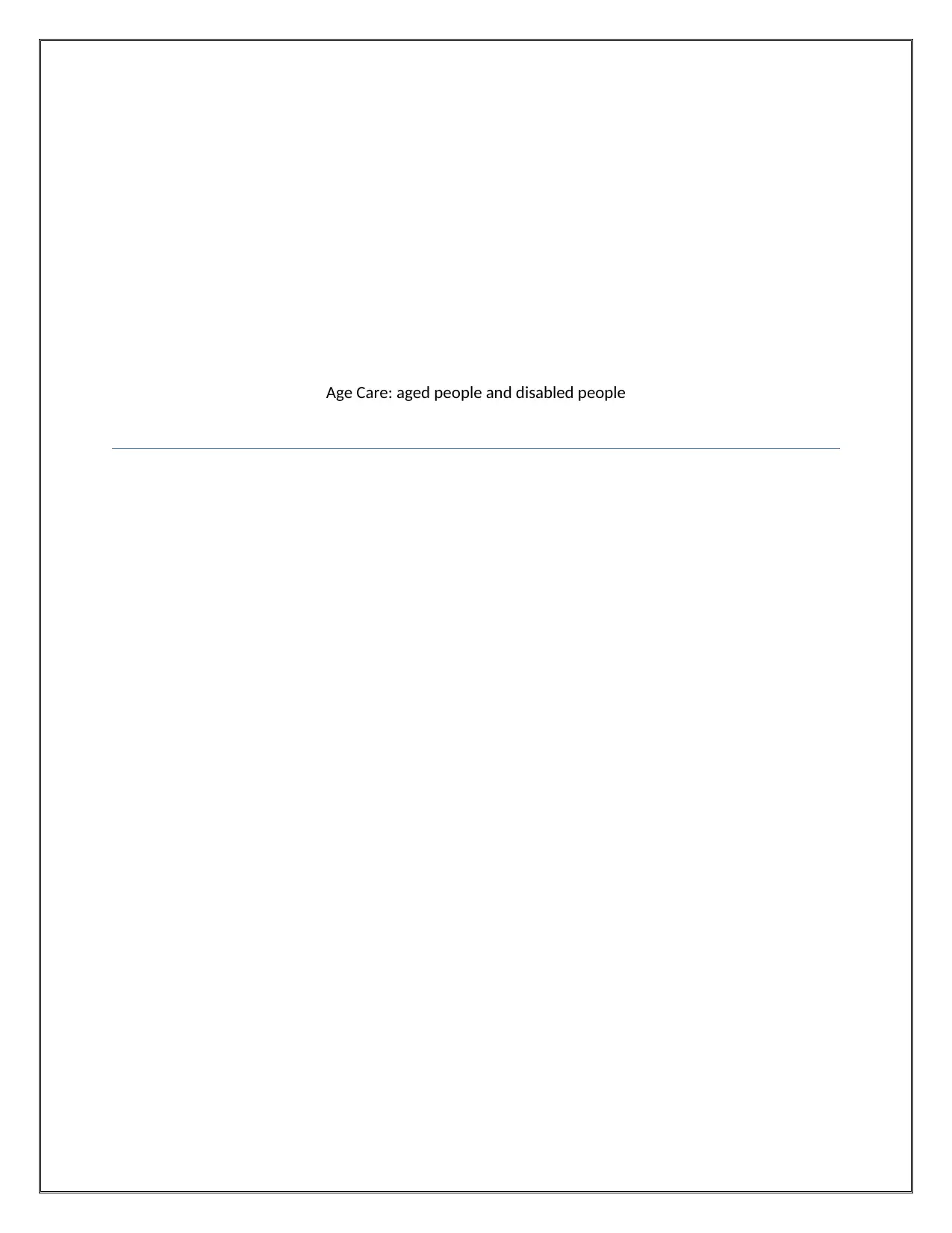
Age Care: aged people and disabled people
Paraphrase This Document
Need a fresh take? Get an instant paraphrase of this document with our AI Paraphraser
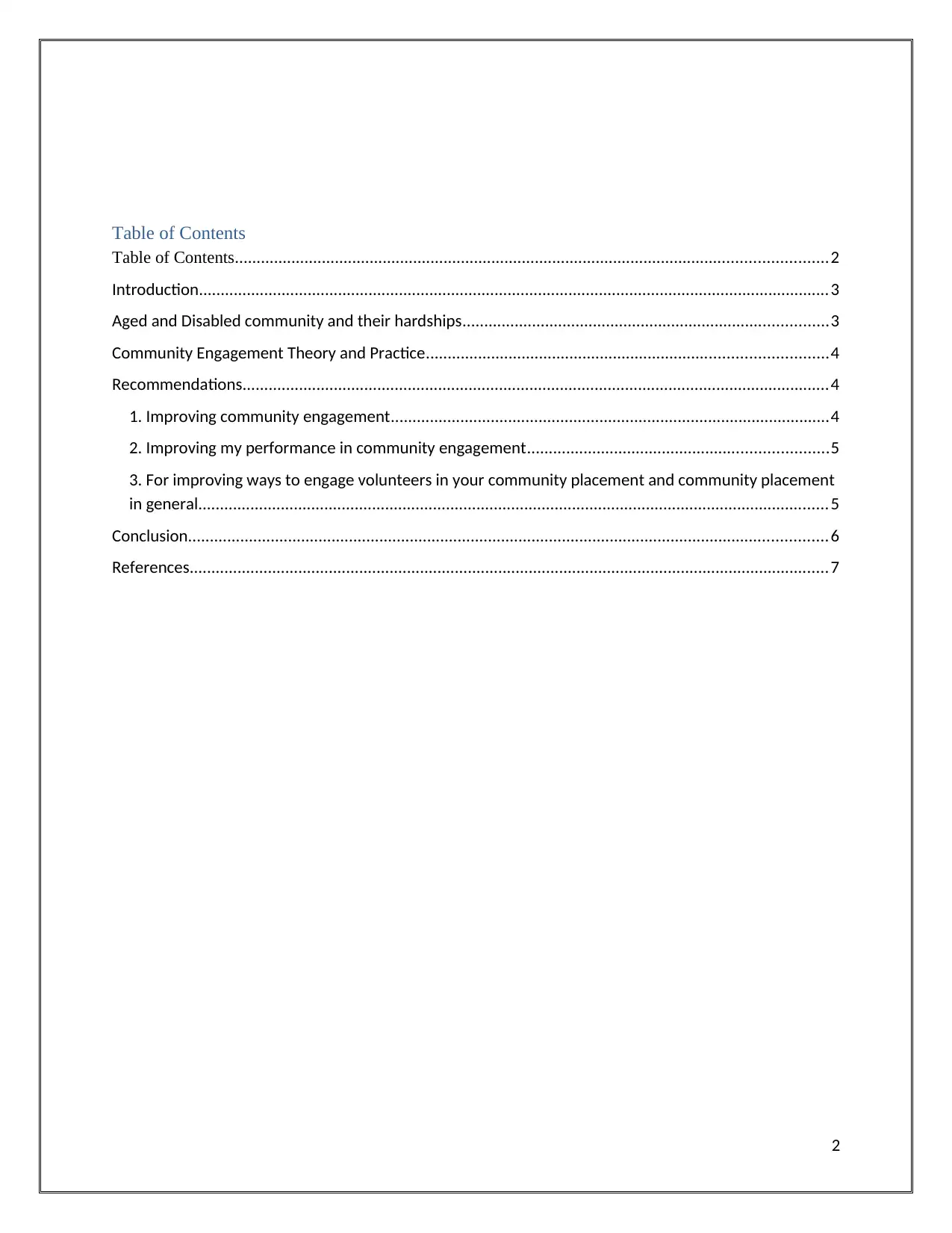
Table of Contents
Table of Contents........................................................................................................................................2
Introduction.................................................................................................................................................3
Aged and Disabled community and their hardships....................................................................................3
Community Engagement Theory and Practice............................................................................................4
Recommendations.......................................................................................................................................4
1. Improving community engagement.....................................................................................................4
2. Improving my performance in community engagement.....................................................................5
3. For improving ways to engage volunteers in your community placement and community placement
in general.................................................................................................................................................5
Conclusion...................................................................................................................................................6
References...................................................................................................................................................7
2
Table of Contents........................................................................................................................................2
Introduction.................................................................................................................................................3
Aged and Disabled community and their hardships....................................................................................3
Community Engagement Theory and Practice............................................................................................4
Recommendations.......................................................................................................................................4
1. Improving community engagement.....................................................................................................4
2. Improving my performance in community engagement.....................................................................5
3. For improving ways to engage volunteers in your community placement and community placement
in general.................................................................................................................................................5
Conclusion...................................................................................................................................................6
References...................................................................................................................................................7
2

Introduction
The elderly and disabled belong to that section of society which often feels neglected and have
hardships getting through each day for the rest of their life. Every simple daily activity may turn
out to be a problem for them as simple chores like washing, eating, taking medicines, getting
from one place to another feels like a humungous task at hand due to their age or disability.
Disabled people and aged people who need special care most often face issues with
transportation. They may drive less every now and then or not drive by any means. They may
need access to an individual vehicle, and for that, they would need to depend on relatives and
parental figures or someone else for assistance. This report shows how community engagement
practices can be beneficial to all groups belonging to this community and how more people
outside the community can engage in such practices.
Aged and Disabled community and their hardships
Individuals who are incapable of moving about on their own can experience transportation
boundaries. As indicated by 2013-2017 information from the American Community Survey, the
handicap rate is 15.1% in provincial networks, which is higher than the incapacity rate in
metropolitan zones. While caring for patients belonging to these communities, I can tell, that it
gets personal at a level where they may be unwilling to co-operate to receive the care because
they feel threatened due to the kind of behavior that has been exhibited to them previously.
Individuals with handicaps living in rustic networks frequently face difficulties getting to and
utilizing different methods of transportation, which can affect wellbeing and personal satisfaction
(Kavanagh et al., 2015). Individuals with incapacities in country regions see social insurance,
organizations, and different sorts of administrations as less available contrasted with their urban
partners and may require extra help to get to transportation both inside and around their locale.
Numerous social insurance offices and administrations in provincial territories may not be open
for individuals with particular kinds of versatility related to inabilities.
People belonging to the aged and disabled community face multiple disadvantages starting from
their regular life activities like food, clothing, and lodging to healthcare issues. Transportation, as
discussed, is one of the main hindrances that they face regularly and it can even be dangerous as
some of them are unable to move from one place to another without external assistance (Krahn et
3
The elderly and disabled belong to that section of society which often feels neglected and have
hardships getting through each day for the rest of their life. Every simple daily activity may turn
out to be a problem for them as simple chores like washing, eating, taking medicines, getting
from one place to another feels like a humungous task at hand due to their age or disability.
Disabled people and aged people who need special care most often face issues with
transportation. They may drive less every now and then or not drive by any means. They may
need access to an individual vehicle, and for that, they would need to depend on relatives and
parental figures or someone else for assistance. This report shows how community engagement
practices can be beneficial to all groups belonging to this community and how more people
outside the community can engage in such practices.
Aged and Disabled community and their hardships
Individuals who are incapable of moving about on their own can experience transportation
boundaries. As indicated by 2013-2017 information from the American Community Survey, the
handicap rate is 15.1% in provincial networks, which is higher than the incapacity rate in
metropolitan zones. While caring for patients belonging to these communities, I can tell, that it
gets personal at a level where they may be unwilling to co-operate to receive the care because
they feel threatened due to the kind of behavior that has been exhibited to them previously.
Individuals with handicaps living in rustic networks frequently face difficulties getting to and
utilizing different methods of transportation, which can affect wellbeing and personal satisfaction
(Kavanagh et al., 2015). Individuals with incapacities in country regions see social insurance,
organizations, and different sorts of administrations as less available contrasted with their urban
partners and may require extra help to get to transportation both inside and around their locale.
Numerous social insurance offices and administrations in provincial territories may not be open
for individuals with particular kinds of versatility related to inabilities.
People belonging to the aged and disabled community face multiple disadvantages starting from
their regular life activities like food, clothing, and lodging to healthcare issues. Transportation, as
discussed, is one of the main hindrances that they face regularly and it can even be dangerous as
some of them are unable to move from one place to another without external assistance (Krahn et
3
You're viewing a preview
Unlock full access by subscribing today!
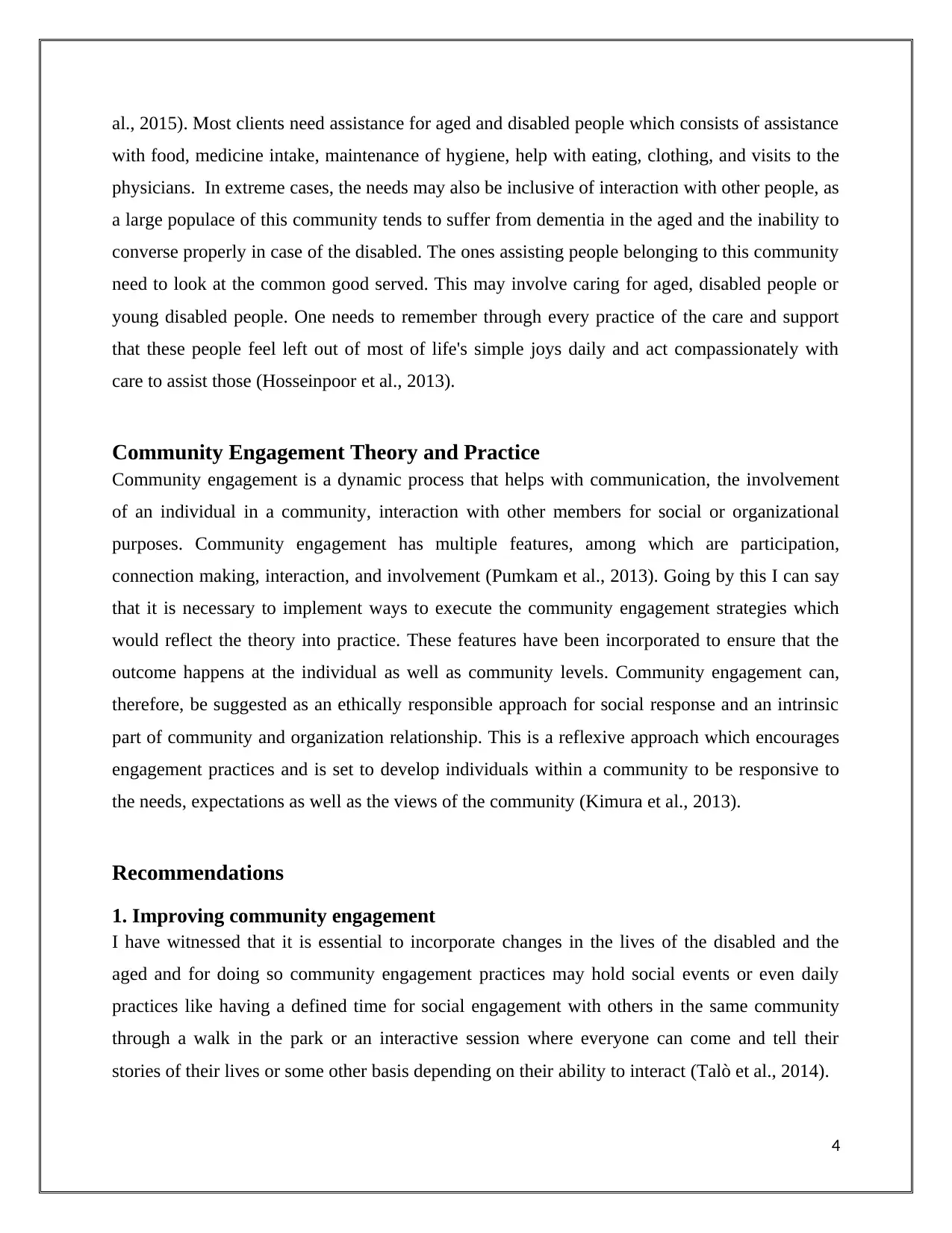
al., 2015). Most clients need assistance for aged and disabled people which consists of assistance
with food, medicine intake, maintenance of hygiene, help with eating, clothing, and visits to the
physicians. In extreme cases, the needs may also be inclusive of interaction with other people, as
a large populace of this community tends to suffer from dementia in the aged and the inability to
converse properly in case of the disabled. The ones assisting people belonging to this community
need to look at the common good served. This may involve caring for aged, disabled people or
young disabled people. One needs to remember through every practice of the care and support
that these people feel left out of most of life's simple joys daily and act compassionately with
care to assist those (Hosseinpoor et al., 2013).
Community Engagement Theory and Practice
Community engagement is a dynamic process that helps with communication, the involvement
of an individual in a community, interaction with other members for social or organizational
purposes. Community engagement has multiple features, among which are participation,
connection making, interaction, and involvement (Pumkam et al., 2013). Going by this I can say
that it is necessary to implement ways to execute the community engagement strategies which
would reflect the theory into practice. These features have been incorporated to ensure that the
outcome happens at the individual as well as community levels. Community engagement can,
therefore, be suggested as an ethically responsible approach for social response and an intrinsic
part of community and organization relationship. This is a reflexive approach which encourages
engagement practices and is set to develop individuals within a community to be responsive to
the needs, expectations as well as the views of the community (Kimura et al., 2013).
Recommendations
1. Improving community engagement
I have witnessed that it is essential to incorporate changes in the lives of the disabled and the
aged and for doing so community engagement practices may hold social events or even daily
practices like having a defined time for social engagement with others in the same community
through a walk in the park or an interactive session where everyone can come and tell their
stories of their lives or some other basis depending on their ability to interact (Talò et al., 2014).
4
with food, medicine intake, maintenance of hygiene, help with eating, clothing, and visits to the
physicians. In extreme cases, the needs may also be inclusive of interaction with other people, as
a large populace of this community tends to suffer from dementia in the aged and the inability to
converse properly in case of the disabled. The ones assisting people belonging to this community
need to look at the common good served. This may involve caring for aged, disabled people or
young disabled people. One needs to remember through every practice of the care and support
that these people feel left out of most of life's simple joys daily and act compassionately with
care to assist those (Hosseinpoor et al., 2013).
Community Engagement Theory and Practice
Community engagement is a dynamic process that helps with communication, the involvement
of an individual in a community, interaction with other members for social or organizational
purposes. Community engagement has multiple features, among which are participation,
connection making, interaction, and involvement (Pumkam et al., 2013). Going by this I can say
that it is necessary to implement ways to execute the community engagement strategies which
would reflect the theory into practice. These features have been incorporated to ensure that the
outcome happens at the individual as well as community levels. Community engagement can,
therefore, be suggested as an ethically responsible approach for social response and an intrinsic
part of community and organization relationship. This is a reflexive approach which encourages
engagement practices and is set to develop individuals within a community to be responsive to
the needs, expectations as well as the views of the community (Kimura et al., 2013).
Recommendations
1. Improving community engagement
I have witnessed that it is essential to incorporate changes in the lives of the disabled and the
aged and for doing so community engagement practices may hold social events or even daily
practices like having a defined time for social engagement with others in the same community
through a walk in the park or an interactive session where everyone can come and tell their
stories of their lives or some other basis depending on their ability to interact (Talò et al., 2014).
4
Paraphrase This Document
Need a fresh take? Get an instant paraphrase of this document with our AI Paraphraser
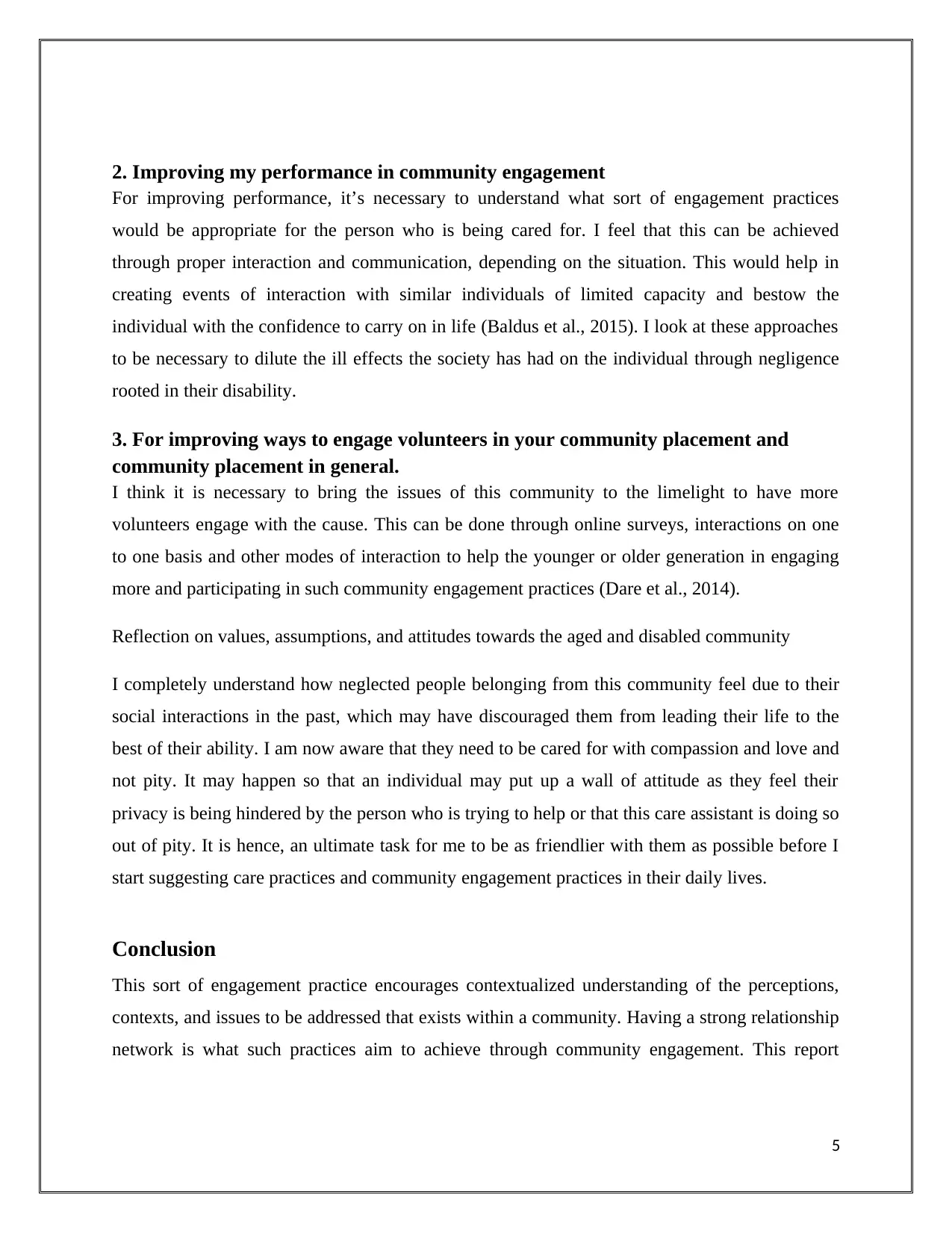
2. Improving my performance in community engagement
For improving performance, it’s necessary to understand what sort of engagement practices
would be appropriate for the person who is being cared for. I feel that this can be achieved
through proper interaction and communication, depending on the situation. This would help in
creating events of interaction with similar individuals of limited capacity and bestow the
individual with the confidence to carry on in life (Baldus et al., 2015). I look at these approaches
to be necessary to dilute the ill effects the society has had on the individual through negligence
rooted in their disability.
3. For improving ways to engage volunteers in your community placement and
community placement in general.
I think it is necessary to bring the issues of this community to the limelight to have more
volunteers engage with the cause. This can be done through online surveys, interactions on one
to one basis and other modes of interaction to help the younger or older generation in engaging
more and participating in such community engagement practices (Dare et al., 2014).
Reflection on values, assumptions, and attitudes towards the aged and disabled community
I completely understand how neglected people belonging from this community feel due to their
social interactions in the past, which may have discouraged them from leading their life to the
best of their ability. I am now aware that they need to be cared for with compassion and love and
not pity. It may happen so that an individual may put up a wall of attitude as they feel their
privacy is being hindered by the person who is trying to help or that this care assistant is doing so
out of pity. It is hence, an ultimate task for me to be as friendlier with them as possible before I
start suggesting care practices and community engagement practices in their daily lives.
Conclusion
This sort of engagement practice encourages contextualized understanding of the perceptions,
contexts, and issues to be addressed that exists within a community. Having a strong relationship
network is what such practices aim to achieve through community engagement. This report
5
For improving performance, it’s necessary to understand what sort of engagement practices
would be appropriate for the person who is being cared for. I feel that this can be achieved
through proper interaction and communication, depending on the situation. This would help in
creating events of interaction with similar individuals of limited capacity and bestow the
individual with the confidence to carry on in life (Baldus et al., 2015). I look at these approaches
to be necessary to dilute the ill effects the society has had on the individual through negligence
rooted in their disability.
3. For improving ways to engage volunteers in your community placement and
community placement in general.
I think it is necessary to bring the issues of this community to the limelight to have more
volunteers engage with the cause. This can be done through online surveys, interactions on one
to one basis and other modes of interaction to help the younger or older generation in engaging
more and participating in such community engagement practices (Dare et al., 2014).
Reflection on values, assumptions, and attitudes towards the aged and disabled community
I completely understand how neglected people belonging from this community feel due to their
social interactions in the past, which may have discouraged them from leading their life to the
best of their ability. I am now aware that they need to be cared for with compassion and love and
not pity. It may happen so that an individual may put up a wall of attitude as they feel their
privacy is being hindered by the person who is trying to help or that this care assistant is doing so
out of pity. It is hence, an ultimate task for me to be as friendlier with them as possible before I
start suggesting care practices and community engagement practices in their daily lives.
Conclusion
This sort of engagement practice encourages contextualized understanding of the perceptions,
contexts, and issues to be addressed that exists within a community. Having a strong relationship
network is what such practices aim to achieve through community engagement. This report
5
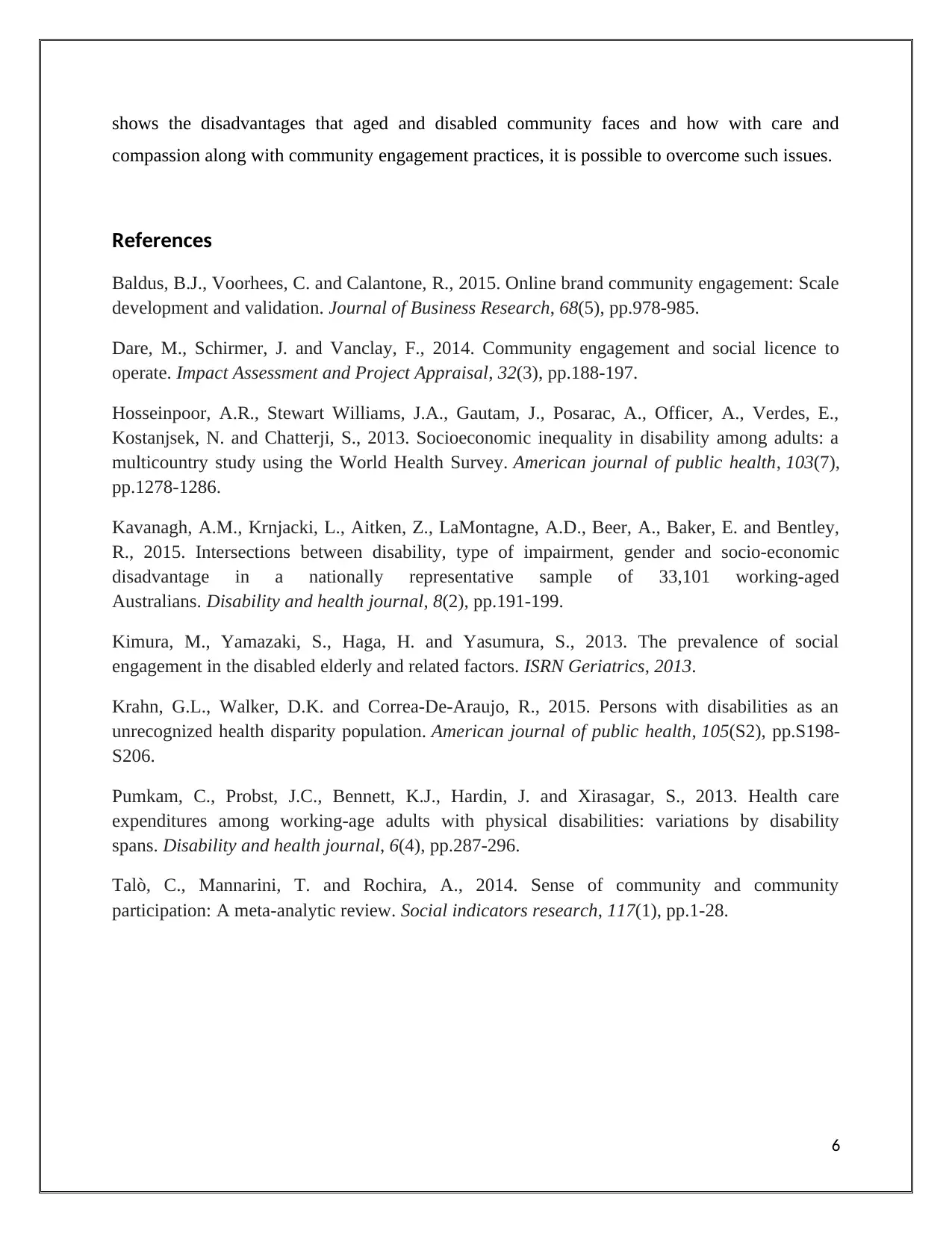
shows the disadvantages that aged and disabled community faces and how with care and
compassion along with community engagement practices, it is possible to overcome such issues.
References
Baldus, B.J., Voorhees, C. and Calantone, R., 2015. Online brand community engagement: Scale
development and validation. Journal of Business Research, 68(5), pp.978-985.
Dare, M., Schirmer, J. and Vanclay, F., 2014. Community engagement and social licence to
operate. Impact Assessment and Project Appraisal, 32(3), pp.188-197.
Hosseinpoor, A.R., Stewart Williams, J.A., Gautam, J., Posarac, A., Officer, A., Verdes, E.,
Kostanjsek, N. and Chatterji, S., 2013. Socioeconomic inequality in disability among adults: a
multicountry study using the World Health Survey. American journal of public health, 103(7),
pp.1278-1286.
Kavanagh, A.M., Krnjacki, L., Aitken, Z., LaMontagne, A.D., Beer, A., Baker, E. and Bentley,
R., 2015. Intersections between disability, type of impairment, gender and socio-economic
disadvantage in a nationally representative sample of 33,101 working-aged
Australians. Disability and health journal, 8(2), pp.191-199.
Kimura, M., Yamazaki, S., Haga, H. and Yasumura, S., 2013. The prevalence of social
engagement in the disabled elderly and related factors. ISRN Geriatrics, 2013.
Krahn, G.L., Walker, D.K. and Correa-De-Araujo, R., 2015. Persons with disabilities as an
unrecognized health disparity population. American journal of public health, 105(S2), pp.S198-
S206.
Pumkam, C., Probst, J.C., Bennett, K.J., Hardin, J. and Xirasagar, S., 2013. Health care
expenditures among working-age adults with physical disabilities: variations by disability
spans. Disability and health journal, 6(4), pp.287-296.
Talò, C., Mannarini, T. and Rochira, A., 2014. Sense of community and community
participation: A meta-analytic review. Social indicators research, 117(1), pp.1-28.
6
compassion along with community engagement practices, it is possible to overcome such issues.
References
Baldus, B.J., Voorhees, C. and Calantone, R., 2015. Online brand community engagement: Scale
development and validation. Journal of Business Research, 68(5), pp.978-985.
Dare, M., Schirmer, J. and Vanclay, F., 2014. Community engagement and social licence to
operate. Impact Assessment and Project Appraisal, 32(3), pp.188-197.
Hosseinpoor, A.R., Stewart Williams, J.A., Gautam, J., Posarac, A., Officer, A., Verdes, E.,
Kostanjsek, N. and Chatterji, S., 2013. Socioeconomic inequality in disability among adults: a
multicountry study using the World Health Survey. American journal of public health, 103(7),
pp.1278-1286.
Kavanagh, A.M., Krnjacki, L., Aitken, Z., LaMontagne, A.D., Beer, A., Baker, E. and Bentley,
R., 2015. Intersections between disability, type of impairment, gender and socio-economic
disadvantage in a nationally representative sample of 33,101 working-aged
Australians. Disability and health journal, 8(2), pp.191-199.
Kimura, M., Yamazaki, S., Haga, H. and Yasumura, S., 2013. The prevalence of social
engagement in the disabled elderly and related factors. ISRN Geriatrics, 2013.
Krahn, G.L., Walker, D.K. and Correa-De-Araujo, R., 2015. Persons with disabilities as an
unrecognized health disparity population. American journal of public health, 105(S2), pp.S198-
S206.
Pumkam, C., Probst, J.C., Bennett, K.J., Hardin, J. and Xirasagar, S., 2013. Health care
expenditures among working-age adults with physical disabilities: variations by disability
spans. Disability and health journal, 6(4), pp.287-296.
Talò, C., Mannarini, T. and Rochira, A., 2014. Sense of community and community
participation: A meta-analytic review. Social indicators research, 117(1), pp.1-28.
6
You're viewing a preview
Unlock full access by subscribing today!
1 out of 6
Your All-in-One AI-Powered Toolkit for Academic Success.
+13062052269
info@desklib.com
Available 24*7 on WhatsApp / Email
![[object Object]](/_next/static/media/star-bottom.7253800d.svg)
Unlock your academic potential
© 2024 | Zucol Services PVT LTD | All rights reserved.
